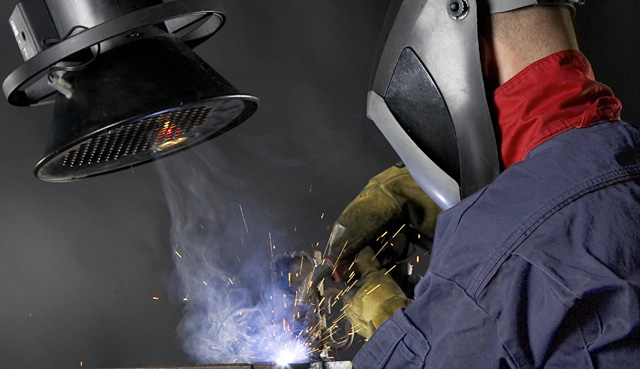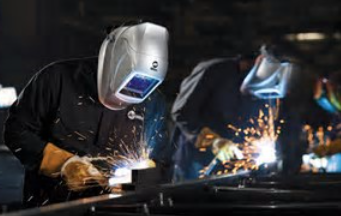Welding Safety FAQs - Fumes and Gases
Health Effects: Fumes
 Q: What compounds are found in common welding fume?
Q: What compounds are found in common welding fume?
A: The most common compounds in arc welding fume mild steel are iron, manganese
and silicon although other compounds in the electrode or on the base metal may
be in the welding fume.
Q: What types of electrode products are likely to have chromium or nickel in the
welding fume?
A: Fumes from the use of stainless steel and hardfacing products contain
chromium or nickel.
Q: What are the potential health effects that may result from long-term
overexposure to chromium or nickel?
A: Asthma has been reported and some forms of these metals are known or
suspected to cause lung cancer in processes other than welding. Therefore, it is
recommended that precautions be taken to keep exposures as low as possible.
Q: What are the potential health effects that may result from sustained
overexposure to manganese?
A: Manganese overexposure may affect the central nervous system, resulting in
poor coordination, difficulty in speaking and tremor of arms or legs. This
condition is considered irreversible.
Q: What are the potential health effects that may result from overexposure to
zinc?
A: Overexposure to zinc may cause fume fever with symptoms similar to the common
flu.
Q: What is a common source of zinc in welding fume?
A: Zinc in welding fume usually comes from welding on galvanized steel.
Warnings
Q: Where can you find safety instructions regarding welding products that you
use?
 A: Each welding power source and container of consumable product has a warning
label which contains specific safety instructions regarding the arc welding
product you have chosen to use.
A: Each welding power source and container of consumable product has a warning
label which contains specific safety instructions regarding the arc welding
product you have chosen to use.
Q: What information is contained on a material safety data sheet (MSDS)?
A: An MSDS contains additional information including a summary of the Hazardous
Materials used to manufacture the product, a summary of Fire and Explosion
Hazard Data, Health Hazard Data and Reactivity Data, and information on the
precautions to observe for the Safe Handling and Use of the product.
Q: Where can you find the MSDS for the consumable product you are using?
A: Inside each Lincoln Electric consumable container. It can also be found on
the Lincoln Electric website, on the AWS website and from your supervisor.
Q: Since fumes and gases can be dangerous to your health, what three steps
should you take to protect yourself?
A: 1) Keep fumes and gases from your breathing zone and general area 2) Keep
your head out of the fumes 3) Use enough ventilation or exhaust at the arc, or
both, to keep fumes and gases from your breathing zone and general area.
Q: What additional precautions should be followed for products that require
special ventilation?
A: If special ventilation products are used indoors, use local exhaust. If
special ventilation products are used outdoors, a respirator may be required.
Q: What types of products generally require special ventilation?
A: Hardfacing and stainless products.
Health Effects: Gases
Q: What are the potential health hazards related to shielding gases used in arc
welding?
A: Most of the shielding gases (argon, helium and carbon dioxide) are non-toxic,
but they can displace oxygen in your breathing air causing dizziness,
unconsciousness and possible death. Carbon monoxide can also be present and may
pose a hazard if levels are excessive.
Adequate Ventilation
Q: What is the one of the most basic safety precautions that a welder can take
to protect themselves from overexposure to welding fume?
A: Keep your head out of the fume plume!
Q: Where is the concentration of fumes and gases greatest?
A: Concentration of fumes and gases is greatest in the plume.
Q: How can you keep fumes and gases away from your breathing zone?
A: Keep fumes and gases from your breathing zone and general area using natural
ventilation, mechanical ventilation, fixed or moveable exhaust hoods, or local
exhaust at the arc.
Q: What precautions must be taken if adequate ventilation cannot be provided?
A: It may be necessary to wear an NIOSH approved respirator if adequate
ventilation cannot be provided.
Q: Does OSHA require engineering or workplace controls be installed before
respirators can be used?
A: OSHA requires that engineering and workplace controls be installed first and
if the controls alone do not keep exposures below applicable limits, use
respirators.
Q: How can a welder determine if there is adequate ventilation?
A: As a practical rule of thumb for welders, for many mild steel electrodes, if
the welder is comfortable and the air is visibly clear, the welder has adequate
ventilation.
Q: What method is used to accurately measure a welder's exposure to welding
fume?
A: A welder's exposure can only be determined by having a qualified professional
take a sample of the welder's breathing air during the workday.
Q: When is it most important to measure a welder's exposure to welding fume?
A: Measuring a welder‘s exposure to welding fume is essential if you are welding
with stainless, hardfacing or other special ventilation products (see the
product label).
Q: What precautions should be taken when welding a base metal which is plated or
painted?
A: If the base metal cannot be cleaned before welding, the composition of the
coating should be evaluated.
Q: What should you do if you feel overexposed to welding fume?
A: Stop welding and get some fresh air immediately. If you continue to feel the
symptoms, see your doctor. Notify your supervisor and co-workers so the
situation can be corrected and other workers are aware of and can avoid the
hazard. Be sure you are following safe practices, as stated upon the consumable
labeling and MSDS, and improve the ventilation in your area. Do not continue
welding until the situation has been corrected.
Q: What does adequate ventilation mean?
A: Your work area has adequate ventilation when there is enough ventilation and
exhaust to control worker exposure to the hazardous materials in the welding
fumes and gases (so the applicable exposure limit for those materials is not
exceeded).
Q: What are the most commonly used exposure limits?
A: The two most common U.S. exposure limits are established by OSHA in the form
of permissible exposure limits or PEL and by the ACGIH in the form of Threshold
Limit Values or TLV.
Q: What exposure limit is mandatory in the United States?
A: Your employer must keep exposures below the PEL.
Q: Where can you find the applicable limits for the PEL and TLV for substances
in welding fume?
A: The PEL and TLV are listed on the first page of the MSDS for compounds in
each electrode or flux.
Evaluating the Welding Environment
Q: What steps can you, the welder, take to identify hazardous substances?
A: There are also steps that you should take to identify hazardous substances in
your welding environment. Read the product label to review the warnings, safety
precautions and to determine if special ventilation is needed. Obtain and review
the material safety data sheet (MSDS) for the electrode which your employer or
supervisor has posted in the work place or that you find inside the electrode or
flux container. You should review the complete MSDS to determine specifically
what compounds you may be exposed to when using the product.
Q: Where can the welder find information about materials in the base metal or
any coating on the base metal?
A: Obtain a copy of the supplier's MSDS for the base metal being welded, as this
should be reviewed as well.
Welding Fume Control
Q: What is natural ventilation?
A: Natural ventilation is the movement of air through the workplace caused by
natural forces. Outside, this is usually the wind. Inside, this may be the flow
of air through open windows and doors.
Q: What is mechanical ventilation?
A: Mechanical ventilation is the movement of air through the workplace caused by
an electrical device such as a portable fan or permanently mounted fan in the
ceiling or wall.
Q: What is local exhaust?
A: Local exhaust is a mechanical device used to capture welding fume at or near
the arc and remove contaminants from the air.
Q: What factors need to be considered when determining the exhaust requirements
for your application?
A: The ventilation or exhaust needed for your application depends upon factors
such as:
Workspace volume
Workspace configuration
Number of welders
Welding process and current
Consumables used (mild steel, hardfacing, stainless, etc.)
Allowable levels (TLV, PEL, etc.)
Material welded (including paint or plating)
Natural airflow
Q: Name several types of local exhaust that can be used to control exposure to
welding fume?
A: Local exhaust of welding fumes can be provided by any of the following:
adjustable "elephant trunk" exhaust systems, fume extraction guns or fixed
enclosures, or booths with exhaust hoods.
Q: Which system is more effective and economical: general ventilation or local
exhaust systems?
A: Local exhaust systems are more effective and economical to operate than a
general ventilation system, particularly in the winter, because they require
less replacement air to be brought into the room and heated.
Q: What is the minimum air velocity (speed) required near the welding arc?
A: Minimum required air velocity at the welding arc is 100 fpm.
Q: When should an employee's exposure to welding fume be obtained?
A: Exposure should be checked when new ventilation equipment is installed, when
the process is modified or when the welder feels uncomfortable. Periodically,
exposure should be re-checked to be sure it is still working properly and is
adequate.
Special Ventilation Reminder
Q: What must be done to insure that there is adequate ventilation when welding
with electrodes that require special ventilation (such as stainless or
hardfacing, or other products which require special ventilation - see
instructions on container or MSDS) or on lead or cadmium plated steel and other
metals or coatings like galvanized steel, which produce hazardous fumes?
A: Keep exposure as low as possible and below exposure limit values (PEL and
TLV) for materials in the fume using local exhaust.
Q: When should a respirator be used?
A: In confined spaces or in some circumstances, for example outdoors, a
respirator may be required if exposure cannot be controlled to the PEL or TLV
(see MSDS).
Q: When does OSHA consider natural ventilation sufficient?
A: According to OSHA regulations, when welding and cutting (mild steels),
natural ventilation is usually considered sufficient to meet requirements,
provided that:
The room or welding area contains at least
10,000 cubic feet (about 22' x 22' x 22') for each welder
The ceiling height is not less than 16 feet
Cross ventilation is not blocked by partitions, equipment or other
structural barriers
Welding is not done in a confined space
Regardless of the whether the ventilation meets these requirements, the welder's
exposure must be controlled to below the PEL or TLV (if applicable) exposure
limit to be adequate